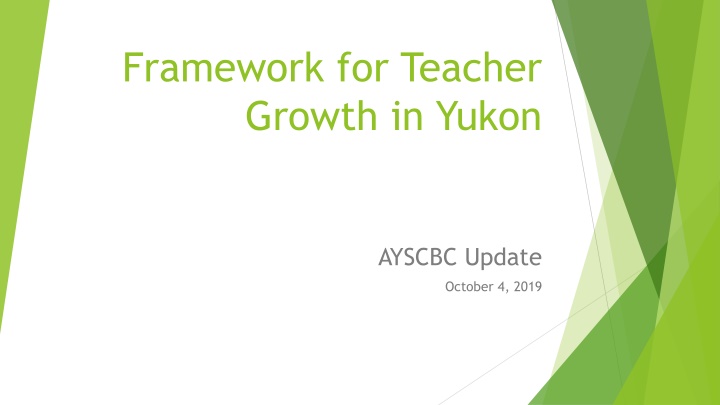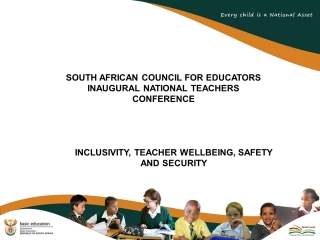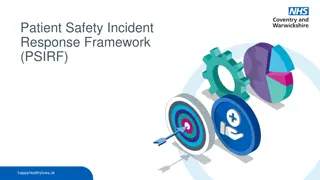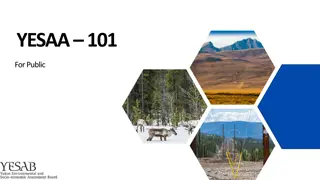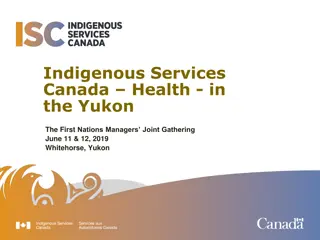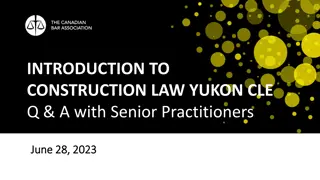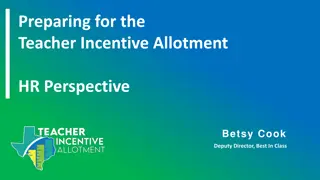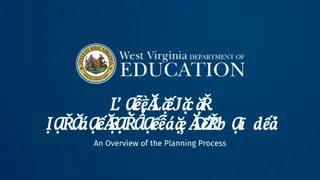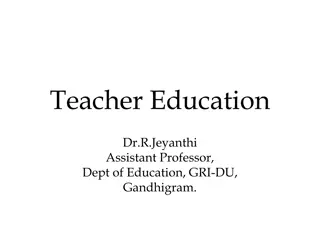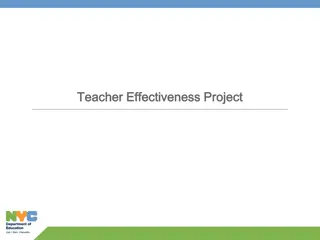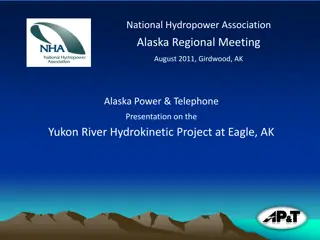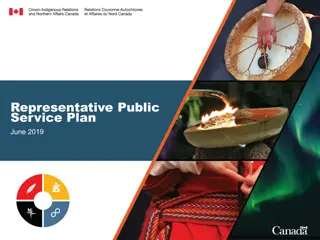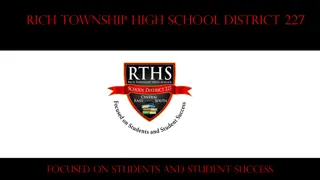Comprehensive Framework for Teacher Growth in Yukon
The Framework for Teacher Growth in Yukon is a detailed description of effective teaching divided into four domains: Planning and Preparation, Classroom Environment, Instruction, and Professional Responsibilities. It provides clear targets for teacher development and offers specific guidance on what these targets should entail within the learning environment. Adapted from Charlotte Danielson's work, this framework is grounded in solid research and teaching principles. The domains cover areas such as knowledge of content and pedagogy, creating a positive classroom environment, instructional practices, and professional responsibilities.
Download Presentation

Please find below an Image/Link to download the presentation.
The content on the website is provided AS IS for your information and personal use only. It may not be sold, licensed, or shared on other websites without obtaining consent from the author.If you encounter any issues during the download, it is possible that the publisher has removed the file from their server.
You are allowed to download the files provided on this website for personal or commercial use, subject to the condition that they are used lawfully. All files are the property of their respective owners.
The content on the website is provided AS IS for your information and personal use only. It may not be sold, licensed, or shared on other websites without obtaining consent from the author.
E N D
Presentation Transcript
Framework for Teacher Growth in Yukon AYSCBC Update October 4, 2019
What is the Framework: The Framework is a comprehensive description of effective teaching divided into four domains. It provides clear targets for teacher growth and specific information of what those targets look like and sound like in the place of learning The strength of the Framework is in providing descriptive information for teachers and administrators that informs their work and decisions, whether these are for formative (developmental) or summative (evaluative) purposes. The Framework for Yukon was adapted from work that was developed by Charlotte Danielson. It is not magic, but it is based on ongoing quality research and sound principles of teaching and learning. The Framework is subject to the wisdom of practice : question the Framework not the common sense
Domain 1 Planning and Preparation Planning and Preparation Domain 1 Domain 2 Classroom Environment Classroom Environment Classroom Environment Domain 2 Domain 2 1a Demonstrating Knowledge of Content & Pedagogy 1b Demonstrating Knowledge of Students 1c Setting Instructional Outcomes 1d Demonstrating Knowledge of Resources 1e Designing Coherent Instruction 1f Designing Student Assessment 2a Creating an Environment of Respect & Rapport 2b Creating a Culture of Learning 2c Managing Classroom Procedures 2d Managing Student Behavior 2e Managing Physical Space 2e Organizing Physical Space 2a Creating an Environment of Respect & Rapport 2b Creating a Culture of Learning 2c Managing Routines and Procedures 2d Managing Student Behaviour Framework for Teacher Growth in Yukon Domain 4 Professional Responsibilities Professional Responsibilities 4a Reflecting on Teaching 4b Maintaining Accurate Records 4c Communicating and Engaging with Families and Caregivers 4d Communicating and Engaging with the Community and Yukon First Nations 4e Participating in Professional Community 4f Growing and Developing Professionally 4g Showing Professionalism Domain 4 Domain 3 Instruction Instruction Instruction Domain 3 Domain 3 3a Communicating with Students 3b Using Questioning and Discussion Techniques 3c Engaging Students in Learning 3d Using Assessment in Instruction 3e Demonstrating Flexibility & Responsiveness 3d Using Assessment in Instruction 3e Demonstrating Flexibility & Responsiveness 3a Communicating with Students 3b Using Inquiry, Questioning and Discussion Techniques 3c Engaging Students in Learning
The Framework for Teaching 4 Domains 23 Components 76 Elements DOMAIN = 3. Instruction COMPONENT = c. Engaging Students in Learning ELEMENT = Grouping of Students
Feedback for Probationary Teachers must include but is not limited to:
Levels of Performance NOT MEETING DEVELOPING MEETING EXCEEDING Lack of Unsafe Harmful Unclear Unaware Poor Unsuitable Inconsistent Partial General Attempts Awareness Moderate Minimal Whole class Consistent Frequent Successful Appropriate Clear Positive Smooth Group Solid Seamless Subtle Skillful Preventative Leadership Students Individual TEACHER DIRECTED SUCCESS STUDENT DIRECTED SUCCESS
Changes Effective for 2019 Probationary period: The probationary period is 950 hours and at least 245 hours of these must be in the same position and school in a single year. Teachers with indeterminate status will complete a Teacher Learning Plan (this replaces the Annual Growth Plan).
Changes (continued) Time lines First formal observation cycle provided within three months of beginning the assignment Additional observations and follow-up as necessary within six months of beginning the assignment Final written summative report within nine months of beginning the assignment Some evaluations may need to be completed in shorter periods of time especially in circumstances of temporary assignments lasting one or two months
Changes (continued) Section 46.01 (2) ... The evaluation framework and process used shall be adapted to reflect the length and timing of the appointment used to satisfy the 245 hour requirement. Probationary employees not evaluated by the Employer during their probationary period are deemed to have successfully completed their probation.
The Teacher Evaluation Process The following evaluation processes must be used for all probationary and post-probationary teachers needing an evaluation. This process includes: 1. Meetings with each probationary or post probationary teacher to discuss: a. Framework for Teacher Growth in Yukon and the components that will be focused on b. Evaluation Report c. Improvement Plan process (if indicated in the Evaluation Report) 2. Development of the tentative timelines for the evaluation processes to ensure: a. Discussion about planning and informal observations is completed before the formal observations. b. There is a reasonable time between the conversation about the formal observation and the observation itself. 3. Review of teacher s planning documents 4. Scheduled but informal classroom observations 5. At least one formal classroom observation cycle and as many formal or informal observations as the evaluator determines are necessary to provide sufficient evidence for an accurate assessment of the teacher s performance. A formal classroom observation cycle shall include the following: a. Pre-observation meeting b. Classroom observation c. Post-observation meeting with written feedback 6. Summative report a. Completion of a summative report that includes a rating of the teacher s overall performance b. Sign off c. Filing of records
Priorities for Evaluation Probationary teachers Teachers that a principal has been requested to evaluate by a school council, school board, or a Yukon First Nation Teachers that have not had an evaluation in the last 3 years A Teacher Learning Plan may take the place of an evaluation with administrator approval and with consultation of the School Council, School Board,and/or local First Nation.
Post-Probationary Teacher Evaluation Process For post-probationary teachers all domains and components will be used in the evaluation. Post-probationary teachers are evaluated on a multi-year cycle. School Councils or a Yukon First Nation may also request an evaluation. Post- probationary teachers will complete a Teacher Learning Plan that will be reviewed and updated each year. Every three (3) years a formal evaluation may be completed. A Teacher Learning Plan may take the place of an evaluation with administrator approval and with consultation of the School Council, School Board, and/or local First Nation. In cases where an evaluation is requested by a School Council, School Board or local First Nation, the evaluation may focus only on a specific area of concern.
Teacher Learning Plan (TLP) Implementation must be reasonable! Teacher authored and directed in consultation and collaboration with principal or vice-principal The TLP includes a Yukon First Nations Ways of Knowing and Doing Self-Assessment Post probationary teachers are required to complete a TLP each year that includes their professional growth goal, action plan, and timelines Process may be sustained over more than a year The TLP must show evidence of how their professional growth impacts student learning Review and update annually and sign by both teacher and principal and keep a copy
Whats next? Review and updating of the principal evaluation process (2019-20) Review and updating of the Educational Assistant evaluation process (2020-21)
